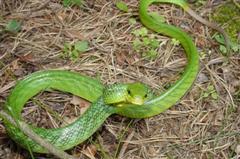Rat Snake - Green Red Tailed
Grey Ratsnake Scientific Name: Elaphe obsoleta spiloides
Sat, 19th April, 2025 - 5:57 am GMT

Alternative Name
Grey Ratsnake Scientific Name: Elaphe obsoleta spiloidesBasic Info
The Gray Rat Snake averages about 1.5 meters in length, or around 5 feet. They can reach up to 7 feet. They are usually brown, tan, white, or gray in color with darker blotches. The pattern and coloration of this species can vary greatly. One variety, known as "Oak Phase", is very light in color. They have very straight sides and weakly keeled scales on the back. The markings are more distinct on younger snakes.
Health
Gray Rat Snakes should be kept in an enclosure that is at least 24 inches long. The temperature in the enclosure should about 80 degrees Fahrenheit during the day, with a basking area in the high 80s, and the temperature should be lowered to the low 70s at night. They should be provided with a hiding place and will also make good use of a branch, that they can use for climbing. Breeding The Gray Rat Snake usually mates in April or June. A month or two after mating, usually between May and July, the female Rat Snake will lay a clutch of between ten and twenty eggs. These eggs will hatch between July and September, resulting in babies between 30 and 35 centimeters in length.Habitat
Found in the sandy soil of sparse woodlandsBehavior
The Gray Rat Snake is larger than most Rat Snakes. They are usually docile, although they can become aggressive when threatened or nervous. Found primarily in the Midwestern United States, the Gray Rat Snake can usually be found in the sandy soil of sparse woodlands.They are mostly arboreal animals, meaning they spend a lot of time in trees. They can often be found hunting or basking on rocks and tree limbs. Gray Rat Snakes do not require hibernation unless they are to be bred. They are quite common in captivity. In the wild, young Gray Rat Snakes are eaten by raptors and carnivorous mammals. The adults grow to a significant length, so they are rarely harmed by anything but humans.Origin
United StatesHistory
The Gray Rat Snake can be found in Indiana, southern Illinois, Mississippi, and Georgia.Common Foods
They feed primarily on large rodents, hence the name "Rat Snake." They will also eat birds and bird eggs."There are three ways in which a ruler can bring misfortune upon his army: (1) By commanding the army to advance or to retreat, being ignorant of the fact that it cannot obey. This is called hobbling the army. (2) By attempting to govern an army in the same way as he administers a kingdom, being ignorant of the conditions which obtain in an army. This causes restlessness in the soldier's minds. (3) By employing the officers of his army without discrimination, through ignorance of the military principle of adaptation to circumstances. This shakes the confidence of the soldiers." -- Sun Tzu, The Art of War
Rat Snake - Green Red Tailed
Coded by: BGID® | ALL RIGHTS RESERVED Copyright © 2000-2025
Disclaimer | Privacy | Report Errors / Contact | Credits


 President of the United States of America - Real Estate mogul, Pageant owner and now one of the most controversial men in political history.
President of the United States of America - Real Estate mogul, Pageant owner and now one of the most controversial men in political history.  Politician, US Vice President and President of the USA - Joseph Robinette Biden Jr.
Politician, US Vice President and President of the USA - Joseph Robinette Biden Jr.  versus
versus  Russia: 'The Evil Empire'? Are they all that bad or is it just the USA trying to portray Russia as bad because they are a world power with land bigger and a society very different from the USA ideal?
Russia: 'The Evil Empire'? Are they all that bad or is it just the USA trying to portray Russia as bad because they are a world power with land bigger and a society very different from the USA ideal?  Global warming has been in and out as the "latest" hot topic for many years. It is, according to modern scientists, the result of man-made industrial pollutants, clearing forested areas, agriculture, etc. But now they are thinking it started way before the Industrial Revolution...
Global warming has been in and out as the "latest" hot topic for many years. It is, according to modern scientists, the result of man-made industrial pollutants, clearing forested areas, agriculture, etc. But now they are thinking it started way before the Industrial Revolution... 
 Corona virus
Corona virus 
 Users with wide screen monitors can benefit from more content on every page.
Users with wide screen monitors can benefit from more content on every page.